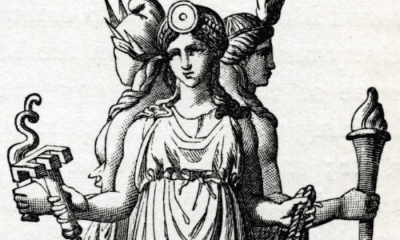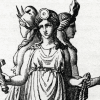Greek
How Was the Minotaur Created?
The Minotaur is one of Greek mythology’s most infamous monsters, but do you know where the bull-headed beast came from?
Beneath the palace of Knossos on the island of Crete, King Minos imprisoned a terrible monster. The Labyrinth held the Minotaur, a mean-eating beast sent to punish the king for his offenses against the gods.
Unlike many monsters of Greek mythology, however, the Minotaur did not come from a long line of terrible creatures. Its mother was Minos’s own wife, Queen Pasiphae.
In punishment for Minos’s oathbreaking, Pasiphae was made to fall in love with an animal. The Cretan Bull had once been a beautiful and gentle gift from Poseidon, but his anger made it a rampaging beast.
The stories of the Cretan Bull and the Minotaur involve both Greece’s legendary heroes and Crete’s founding king. Their real-world origins, however, are in the lost culture of Bronze Age Crete and the religion that dominated the pre-Greek Mediterannean.
The Birth of the Minotaur
The story of the Minotaur begins with Europa’s abduction to Crete by Zeus. Their sons were raised by Asterion, the island’s founding king, after he married Europa.
Asterion left his new kingdom to Minos, the eldest of the brothers. The three sons of Europa argued over who was most qualified to lead, however.
Minos eventually prevailed and banished his brothers from the island. He asked Poseidon to send him a white bull as a sign of the gods’ favor and swore to sacrifice the bull in thanks.
Poseidon sent a beautiful bull to Minos, but when it had arrived the king chose to keep it. He thought the gods would accept another sacrifice in its place and offered up a common bull instead.
Poseidon did not accept the lesser sacrifice, however. The god of the sea was insulted that a mortal had broken an oath to him and taken his gift for granted.
To punish Minos for this insult, Poseidon first turned the noble bull against him. The gentle animal became wild and enraged, destroying both fields and homes as it rampaged throughout the island.
The Cretan Bull would run wild for years and destroy many farms and villages on Crete. Eventually, it would be captured by Hercules, but that would not be the end of Poseidon’s punishments.
Before the bull was captured by Hercules, the god of the sea called on Eros to inflict another terrible punishment on Minos.
Eros used one of his arrows to make the king’s wife, Pasiphae, fall madly in love with the animal. The queen became obsessed with the creature.
Pasiphae called on the famous architect and inventor who served in the Cretan, Daedalus, to help her get close to the object of her desires. Under her command, the reluctant inventor built a wooden cow that the queen could climb into.
Disguised in her artificial cow, the queen went to a field the Cretan Bull was known to be fond of grazing in. In her wooden construct, she conceived a monster.
The child was born with the head of a bull, immediately betraying his heritage. While he was originally called Asterion after the late king, he came to be known as Minotaur, or the “Bull of Minos.”
Pasiphae cared for her monstrous child as she would any other, but it grew more terrible and vicious over time. The Minotaur was a man-eating monster who threatened the safety of the entire island.
King Minos needed to control the Minotaur, but could not kill his wife’s son. Once again, Daedalus was called on to solve the issue.
He designed the Labyrinth, a massive maze-like structure, to imprison the beast. Locked in the dark, the Minotaur could not find its way out of the twisting, tunnel-like corridors.
Neither could its victims. Minos had recently conquered the city of Athens and used his grudge against that city to satiate the monster’s terrible hunger.
The Minotaur was a cannibal, and Minos demanded that its victims come from Athens. Seven young men and seven young women would be sent to Crete at regular intervals to sacrifice to the unnatural monster.
The Minotaur was eventually killed by one of these young people. Theseus, the prince of Athens, traveled to Crete with the other youths who were to be sacrificed and killed the monster.
My Modern Interpretation
The story of the Cretan Bull and the birth of the Minotaur was almost certainly inspired by the ancient religion and rituals of the island of Crete.
In the classical era Crete was somewhat culturally distinct from mainland Greece. This was rooted in the ancient past, hundreds of years before the height of Greek civilization, when Crete had been the home of its own Bronze Age civilization.
The ancient Minoan culture, named by modern archaeologists for the legendary King Minos, was the first highly advanced civilization in ancient Europe. In the early Bronze Age, the capital of Knossos featured sophisticated multi-story buildings, indoor plumbing, and advanced architecture.
The Minoans had a system of writing, but it has unfortunately never been translated. What we know of their culture comes from surviving art and ruins and what we can glean from Greek mythology about the island.
Bulls seem to have been an important part of Minoan religion. Many modern historians believe that a bull cult was one of Crete’s most important institutions, if not its central religious cult.
Many frescos and statues found on at Knossos and elsewhere on the island depict men leaping over the horns of oversized bulls. Women are sometimes shown in similar images as well.
Altars from the Minoan era were sometimes topped with bull horns. Plutarch mentioned a surviving altar of this type on the nearby island Delos as a wonder of the world, and the tradition may have inspired stories of Apollo building an altar from bones and horns as a child.
The Greeks not only saw some of this artwork, but they also inherited some of the stories told by the Minoans themselves. When the first Greek-speaking people entered the region, they incorporated some aspects of the Cretan religion into their own.
Bull remained strongly associated with the island of Crete in Greek mythology. Zeus took Europa to the island in the form of a white bull, and Poseidon sent a similar animal to Minos as a sign of his favor.
Greek tradition, however, never completely forgot that the mainland had once been dominated by the culture and power of Crete. While the Minoan civilization collapsed in the Bronze Age, probably due in part to a volcanic eruption, the descendants of the Mycenaean Greeks continued to see the island’s king as an antagonist.
Thus, while Minos was considered a heroic founding king on Crete itself, the Athenians depicted him as a villainous tyrant. The sacred bulls of Bronze Age Crete were re-imagined as monsters that terrorized both the Cretans and the people of Greece itself.
Some historians believe that the image of the Minotaur may have been based on the priests of the ancient Minoan bull cult. Whether they performed human sacrifices or not, priests who wore bull masks or headpieces were seen as a threatening aspect of Cretan dominance by Bronze Age Greek mainlanders.
It will probably never be known whether the Minoans actually sacrificed young people of Greece to their bull god or if the story of Theseus is another example of the exaggeration of a story over time. The art and archaeology of Crete, however, make it clear that the bull-headed monster had its origins in the religion of the island’s lost culture.
In Summary
In Greek mythology, the Minotaur was the offspring of the Cretan Bull and Queen Pasiphae of Crete. King Minos’s wife had been made to fall in love with the beast as part of Poseidon’s punishments of Minos for breaking an oath.
The bull had once been a gift that Minos promised to sacrifice to the gods after taking power. When he broke his vow, however, Poseidon caused the creature to go mad.
He also caused Pasiphae to conceive the bull’s child. The Minotaur, of “Bull of Minos,” was her cannibalistic, bull-headed child.
Minos imprisoned the man-eating monster in the Labyrinth beneath his capital. It was eventually killed by Theseus, the same hero who had destroyed its father.
The Greeks were probably inspired to feature bulls in their legends of Crete by both oral tradition and the sites of the island itself. The Bronze Age culture of Crete, called the Minoan after its legendary king, features bulls prominently in its art.
Historians believe that bulls played an important role in Cretan religion. Long after the Minoan civilization had declined, cultural tradition led the Greeks to remember its dominance by envisioning its gods, priests, and kings as monsters and villains in their own legends.



